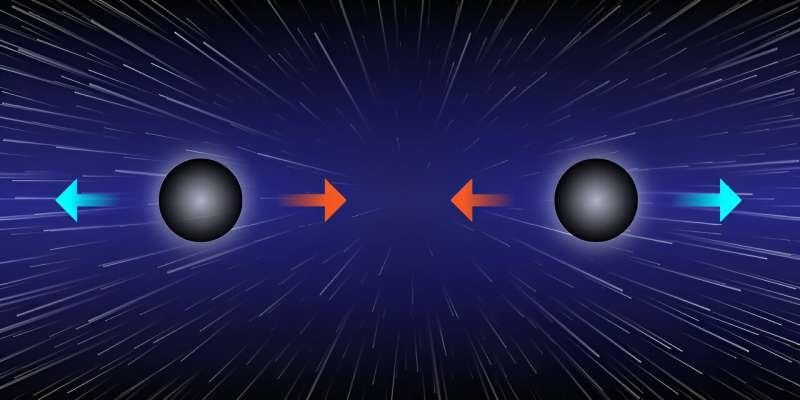This article has been reviewed according to Science X's editorial process and policies. Editors have highlighted the following attributes while ensuring the content's credibility:
fact-checked
peer-reviewed publication
trusted source
proofread
Black holes could come in 'perfect pairs' in an ever expanding universe

Researchers from the University of Southampton, together with colleagues from the universities of Cambridge and Barcelona, have shown it's theoretically possible for black holes to exist in perfectly balanced pairs—held in equilibrium by a cosmological force—mimicking a single black hole.
Black holes are massive astronomical objects that have such a strong gravitational pull that nothing, not even light, can escape. They are incredibly dense. A black hole could pack the mass of the Earth into a space the size of a pea.
Conventional theories about black holes, based on Einstein's theory of General Relativity, typically explain how static or spinning black holes can exist on their own, isolated in space. Black holes in pairs would eventually be thwarted by gravity attracting and colliding them together.
However, this is true if one assumes the universe is standing still. But what about one which is constantly moving? Could pairs of black holes exist in harmony in an ever expanding universe, perhaps masquerading as one?
"The standard model of cosmology assumes that the Big Bang brought the universe into existence and that, approximately 9.8 billion years ago, it became dominated by a mysterious force, coined 'dark energy', which accelerates the universe at a constant rate," says Professor Oscar Dias of the University of Southampton.
Scientists refer to this mysterious force as a 'cosmological constant'. In a universe explained by Einstein's theory with a cosmological constant, black holes are immersed in a cosmological accelerated background. This moves the theoretical goal posts over how black holes can interact and exist together.
Through complex numerical methods, the team behind this latest study show that two static (non-spinning) black holes can exist in equilibrium—their gravitational attraction offset by the expansion associated with a cosmological constant. Even in the acceleration of an ever expanding universe, the black holes remain locked at a fixed distance from one another. As hard as expansion may try to pull them apart, the gravitational attraction compensates.
"Viewed from a distance, a pair of black holes whose attraction is offset by cosmic expansion would look like a single black hole. It might be hard to detect whether it is a single black hole or a pair of them," comments Professor Dias.
Professor Jorge Santos of the University of Cambridge adds, "Our theory is proven for a pair of static black holes, but we believe it could be applied to spinning ones too. Also, it seems plausible that our solution could hold true for three or even four black holes, opening up a whole range of possibilities."
This study was conducted by Professor Oscar Dias (University of Southampton), Professor Gary Gibbons (University of Cambridge), Professor Jorge Santos (University of Cambridge) and Dr. Benson Way (University of Barcelona). Their paper "Static Black Binaries in de Sitter Space" is published in the journal Physical Review Letters and reviewed as a Viewpoint article.
More information: Óscar J. C. Dias et al, Static Black Binaries in de Sitter Space, Physical Review Letters (2023). DOI: 10.1103/PhysRevLett.131.131401
Journal information: Physical Review Letters
Provided by University of Southampton





















